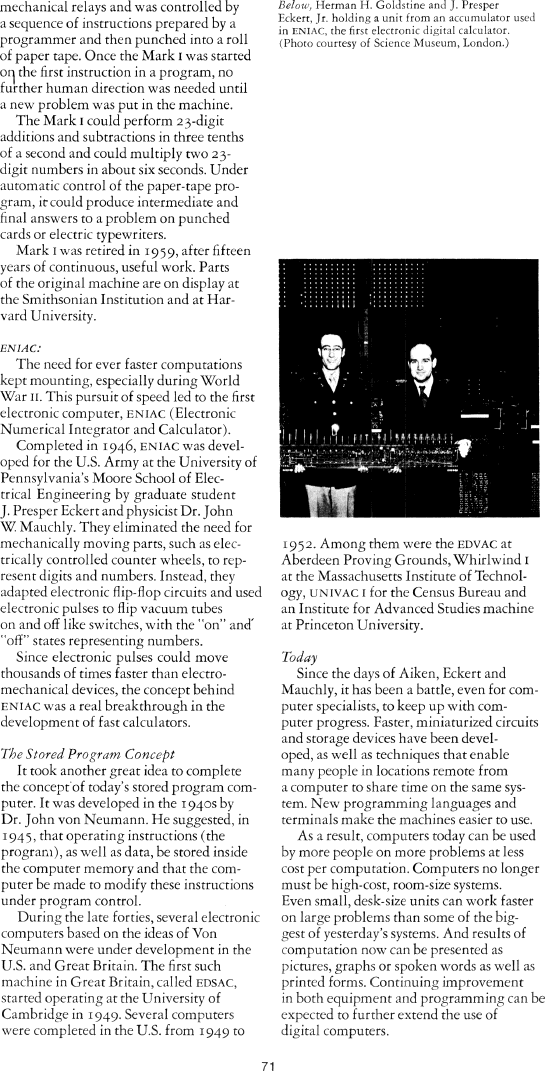The Best of Creative Computing Volume 1 (published 1976)
Digital Calculators - Then And Now (ENIAC, The Stored Program Concept)

mechanical relays and was controlled by a sequence of instructions prepared by a
programmer and then punched into a roll of paper tape. Once the Mark I was
started on the first instruction in a program, no further human direction was
needed until a new problem was put in the machine.
The Mark I could perform 23-digit additions and subtractions in three tenths
of a second and could multiply two 25digit numbers in about six seconds. Under
automatic control of the paper-tape program, it could produce intermediate and
final answers to a problem on punched cards or electric typewriters.
Mark I was retired in 1959, after fifteen years of continuous, useful work.
Parts of the original machine are on display at the Smithsonian Institution and
at Harvard University.
ENIAC:
The need for ever faster computations kept mounting, especially during World
War II. This pursuit of speed led to the first electronic computer, ENIAC
(Electronic Numerical Integrator and Calculator).
Completed in 1946, ENIAC was developed for the U.S. Army at the University of
Pennsylvania's Moore School of Electrical Engineering by graduate student
J. Presper Eckert and physicist Dr. john W Mauchly. They eliminated the need for
mechanically moving parts, such as electrically controlled counter wheels, to
represent digits and numbers. Instead, they adapted electronic flip-flop
circuits and used electronic pulses to flip vacuum tubes on and off like
switches, with the "on” and' "off" states representing numbers.
Since electronic pulses could move thousands of times faster than
electromechanical devices, the concept behind ENIAC was a real breakthrough in
the development of fast calculators.
The Stored Program Concept
It took another great idea to complete the concept of today's stored program
computer. It was developed in the 1940s by Dr. John von Neumann. He suggested,
in 1945, that operating instructions (the program), as well as data, be stored
inside the computer memory and that the computer be made to modify these
instructions under program control.
During the late forties, several electronic computers based on the ideas of
Von Neumann were under development in the U.S. and Great Britain. The first such
machine in Great Britain, called EDSAC, started operating at the University of
Cambridge in 1949. Several computers were completed in the U.S. from 1949 to
Below, Herman H. Goldstine and J Presper Eckert, jr. holding a unit from an
accumulator used in ENIAC, the first electronic digital calculator.(Photo
courtesy of Science Museum, London.)
1952. Among them were the Eovac at Aberdeen Proving Grounds,Whirlwind I
at the Massachusetts Institute of Technology, UNIVAC I for the Census Bureau and
an Institute for Advanced Studies machine at Princeton University.
Today
Since the days of Aiken, Eckert and Mauchly, it has been a battle, even for
computer specialists, to keep up with computer progress. Faster, miniaturized
circuits and storage devices have been developed, as well as techniques that
enable many people in locations remote from a computer to share time on the same
system. New programming languages and terminals make the machines easier to use.
As a result, computers today can be used by more people on more problems at
less cost per computation. Computers no longer must be high-cost, room-size
systems.Even small, desk-size units can work faster on large problems than some
of the biggest of yesterday's systems. And results of computation now can be
presented as pictures, graphs or spoken words as well as printed forms.
Continuing improvement in both equipment and programming can be expected to
further extend the use of digital computers.


